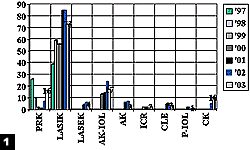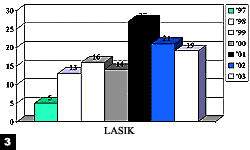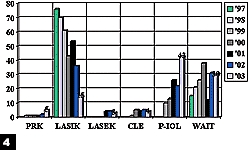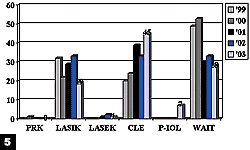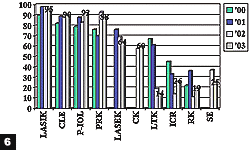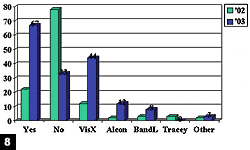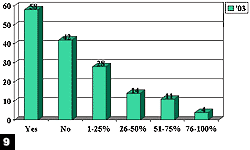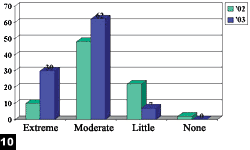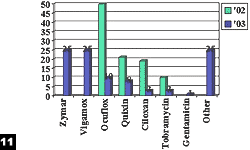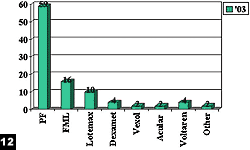Survey: LASIK the preferred surgical procedure for many cases
U.S. refractive surgery trends were analyzed in the 2003 ISRS/AAO survey.
| A note from the editors: This article originally appeared in the Journal of Refractive Surgery, a SLACK Incorporated publication. |
![Richard J. Duffey [photo]](/~/media/images/news/print/ocular-surgery-news/2005/03_march_15/duffey_70_90_5906.jpg) Richard J. Duffey |
The 2003 Refractive Surgery Survey by the U.S. members of the International Society of Refractive Surgery of the American Academy of Ophthalmology was completed in October 2003. The survey was mailed in mid-August to approximately 1,100 U.S. members of ISRS/AAO, and 135 responses were analyzed by October 15, representing 12.5% of the membership. This was the seventh year of refractive data collection, allowing an analysis of trends among U.S. surgeons over the previous years.
Refractive surgeries included in the study were RK, astigmatic keratotomy (AK), limbal relaxing incisions (LRI), PRK, LASIK, laser epithelial keratomileusis (LASEK), intracorneal rings (ICR), laser thermal keratoplasty (LTK), conductive keratoplasty (CK), clear lens extraction (CLE), phakic IOLs and scleral expansion (SE) procedures. Comparisons were made in companies that produce lasers, microkeratomes and topography units. New questions regarding custom ablation, wavefront analyzers, pupil gauge instrumentation, postoperative antibiotics/ anti-inflammatories and comanagement were included in this year’s survey.
Survey results
The percentage of ISRS/AAO U.S. surgeons performing PRK at a rate of at least five cases per month was 16%, up from 2% in 2001 and down from 26% in 1997, before LASIK took off (Figure 1). LASIK has increased from 39% to 73% in that same time period. Forty-one percent of surgeons are performing a moderate volume of at least 25 LASIK cases per month, up from 15% in 1997 (Figure 2). Highvolume LASIK surgery, defined as at least 75 cases per month, is being performed by 27% of members surveyed in 2001, up from 5% in 1997 but decreasing to 19% in this survey (Figure 3).
LASIK continues to be the preferred surgical procedure for a 30- year-old, 3 D myope, with 94% of surgeons choosing this option. Similarly, 95% of surgeons surveyed would choose LASIK over all other forms of refractive surgery for a 30-year-old, 7 D myope. LASIK is preferred for a high myope (–12 D) by only 15% of surgeons (down from 35% in the last survey and 75% in 1997), whereas a phakic IOL would be recommended by 43% of surgeons surveyed, with 30% of surgeons waiting for a better surgical alternative (Figure 4).
LASIK was the preferred surgical choice by 69% of surgeons for a 45- year-old, 1 D hyperope, with only 2% recommending LTK and 21% CK. Seventy-nine percent of surgeons recommended LASIK for a 3 D hyperope; this dropped to 19% for a 5 D hyperope, with 45% recommending CLE and 28% recommending waiting for a better surgical alternative (Figure 5).
|
|
|
|
|
|
|
Sources: Duffey R and Leaming D |
|
Ninety-nine percent of surgeons said they were willing to perform bilateral LASIK surgery at the same surgical session on their patients, up from 64% in 1997. Fifty-eight percent would be willing to perform bilateral PRK surgery at the same surgical session, with 80% indicating it was acceptable to perform such for CK and LASEK patients. More than half the surgeons surveyed said they are presently performing and/or plan to perform in the future the following procedures: LASIK, PRK, CLE, phakic IOLs, LASEK and CK, with 50% doing so for RK, ICR LTK and SE procedures (Figure 6). Twenty-one percent of surgeons surveyed have had LASIK surgery performed on themselves compared to 7% for PRK (Figure 7).
The topography unit most commonly used today is the Zeiss-Humphrey unit (37%) followed by Orbscan (30%), EyeSys (14%) and Tomey (6%). The Orbscan (Bausch & Lomb) has shown the greatest growth over the past 6 years. Visx is still the dominant U.S. excimer laser, used by 63% of respondents, down from 81% in 1999. This was followed by Alcon at 22%, Bausch & Lomb Technolas 12% and Nidek 3%. The Hansatome accounts for 50% of microkeratome use followed by the four Moria units, totaling 25%. The IntraLase femtosecond laser for flap cutting has shown the greatest growth, to 8% in 2003, 3 years after its FDA approval in the United States.
Wavefront analyzers have reached the majority of respondents, with 67% using them in their clinical practices (Figure 8). Of the aberrometry users, 66% use Visx, 26% Alcon, 6% Bausch & Lomb and 3% Tracey. Wavefront-guided custom ablations are performed with varying frequency by 58% of physicians surveyed (Figure 9). Ninety-three percent of surgeons have indicated that custom LASIK has added a moderate to extreme value to laser ablations (Figure 10) and are charging, on average, $300 more per eye for this technology. The practice of comanagement by respondent surgeons dropped from 80% in 2002 to 36% in 2003.
Forty-seven percent noted use of the Colvard infrared pupillometer for pupil size documentation, followed by 32% for a pupil card and 6% for the Keeler Procyon infrared unit. Fourth-generation fluoroquinolones have overtaken the refractive surgery antibiotic landscape with 25% use of Zymar (Allergan) and 25% Vigamox (Alcon) (Figure 11). Pred Forte (Allergan) and FML (Allergan) dominate as postoperative anti-inflammatories (Figure 12).
|
|
|
|
|
|
|
Images: Duffey R and Leaming D |
|
Discussion
LASIK remains the dominant refractive surgery for patients with refractive errors ranging from 3 to 8 D. Phakic IOLs are preferred for high myopes and CLE for high hyperopes. Bilateral, same surgical session LASIK, LASEK, PRK and CK are standard of care among U.S. ISRS/AAO members but not with intraocular lens surgeries. The mainstream future appears dead and/or dying for RK, ICR and LTK, but much brighter for LASIK, PRK, CLE, phakic IOLs, LASEK and CK. Visx is used two-to-one over all other lasers combined, and wavefront analyzers and custom ablations have already made their mark in the industry. Pupillary gauge measurements and documentation are now dominated by infrared instruments. Surgeons have placed a moderate to extreme value on custom LASIK and are charging, on average, $300 more per eye for this technology. Comanagement of laser refractive surgery patients dropped severely over the past year.
For Your Information:
- Richard J. Duffey, MD, can be reached at 2880 Dauphin St., Mobile, AL 36606; 251-470-8928; fax: 251-470-8924; e-mail: duffey@duffeylaser.com.
- Presented at the ISRS/AAO Annual Meeting; November 14, 2003; Anaheim, Calif.
References:
- Duffey RJ, Leaming D. US trends in refractive surgery: 2001 International Society of Refractive Surgery Survey. J Refract Surg. 2002;18:185-188.

